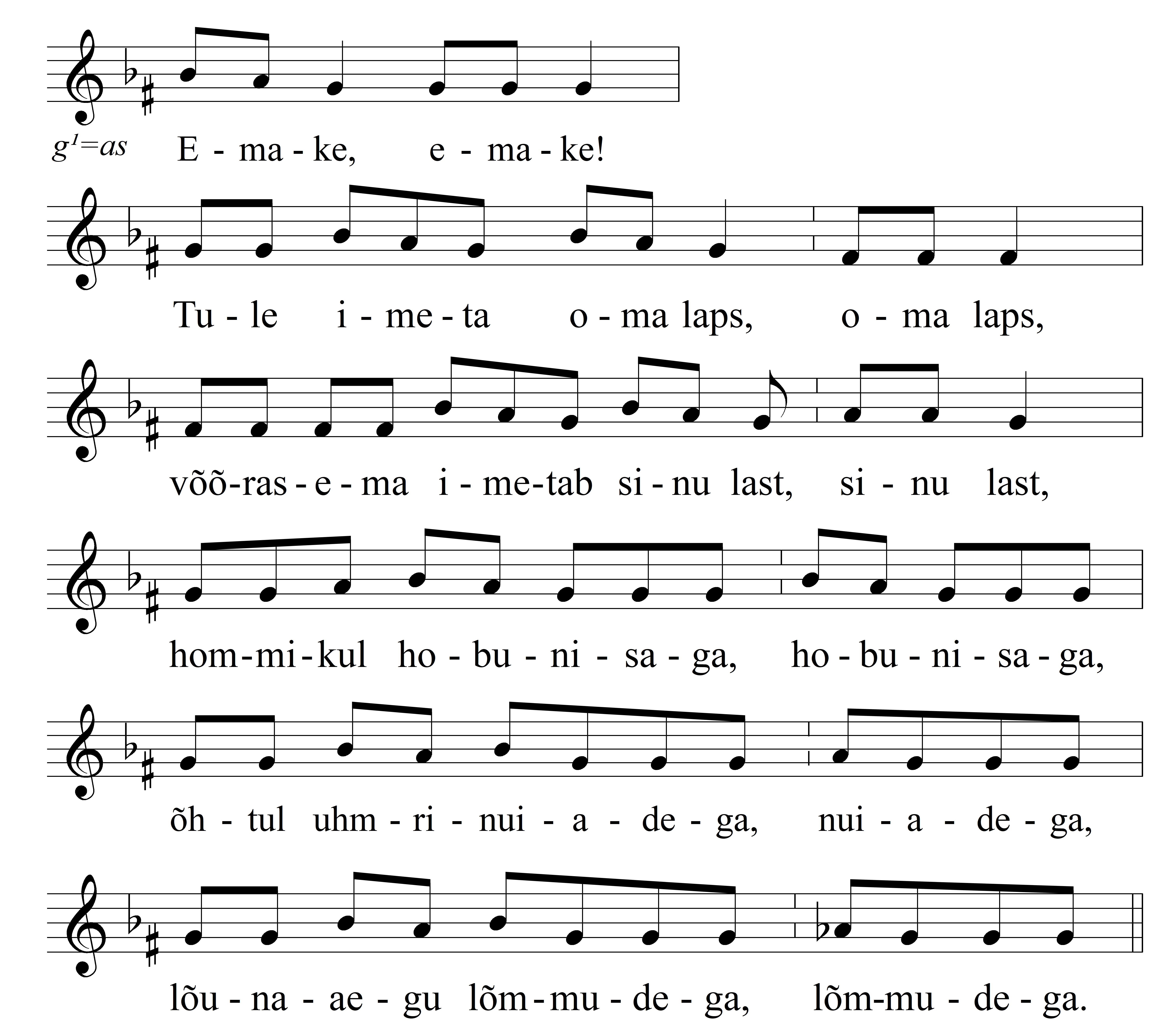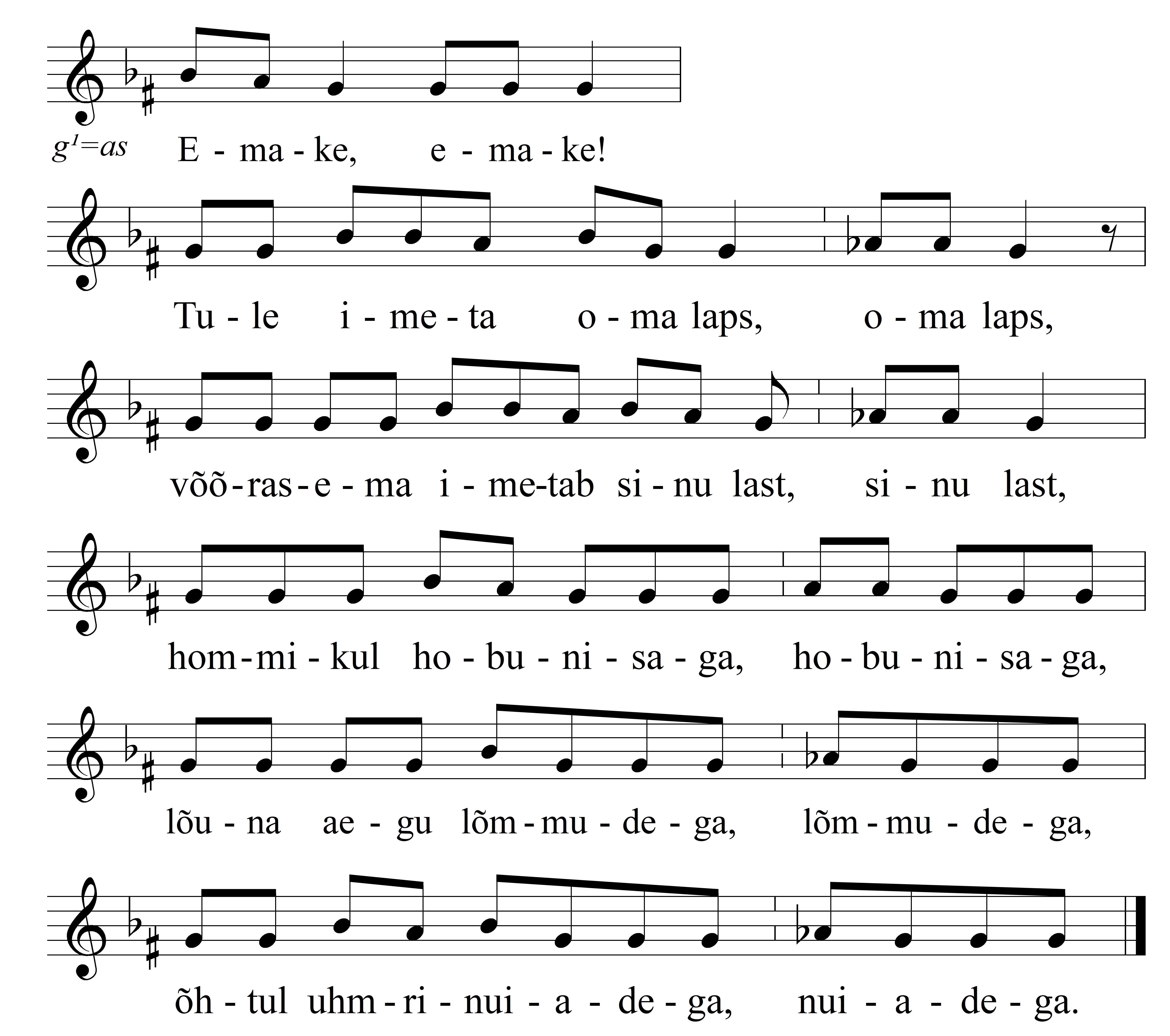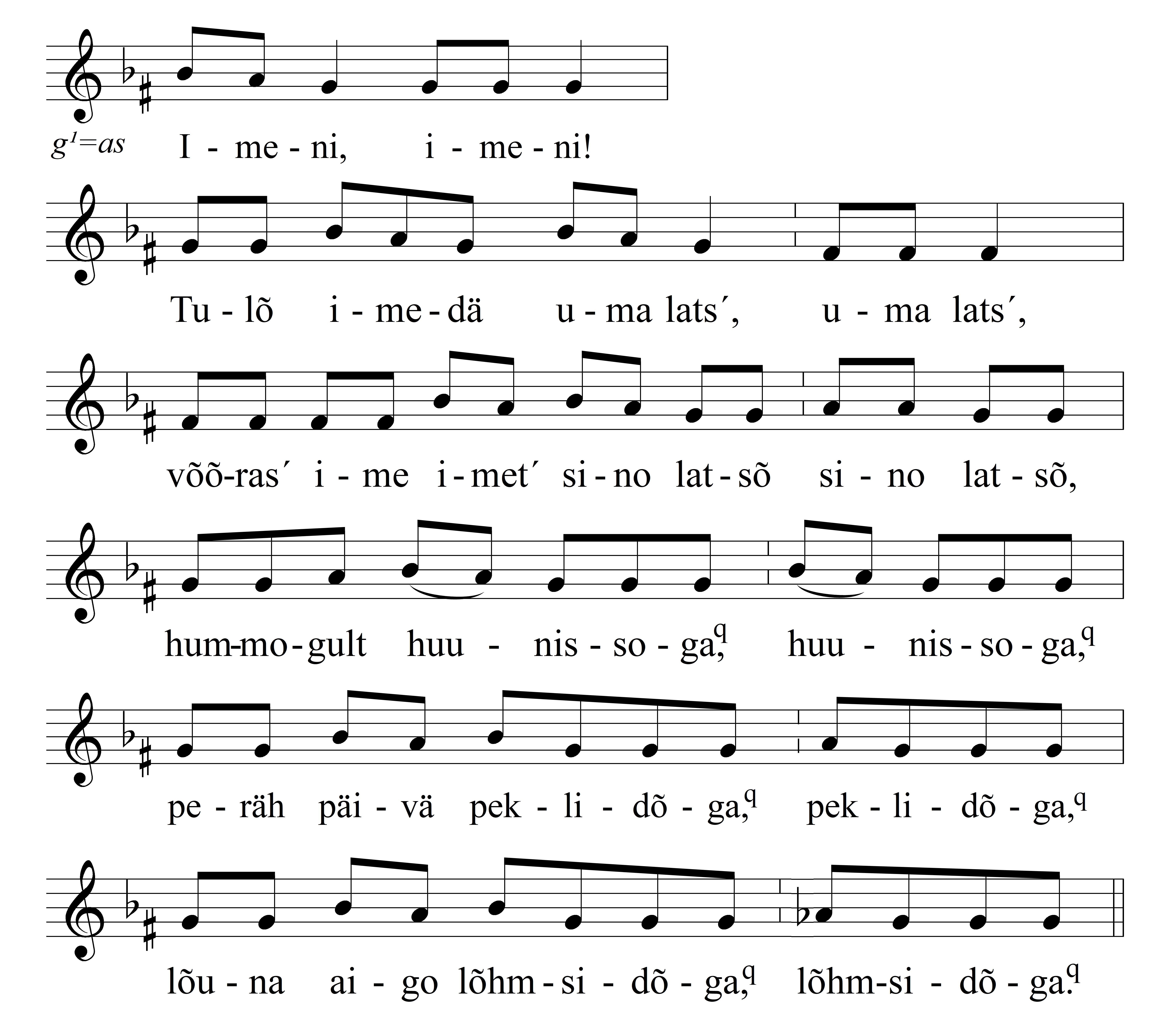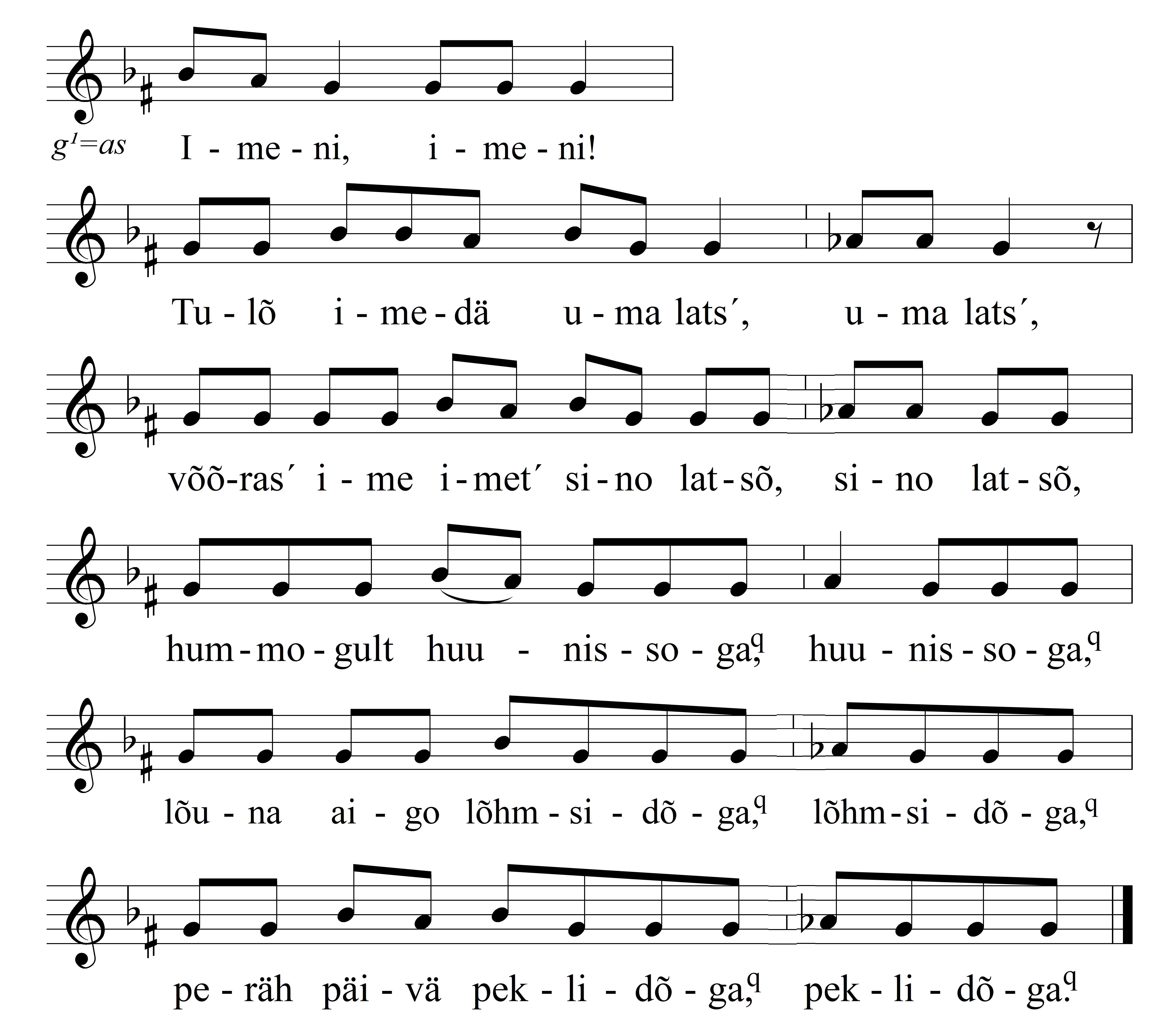Animals
The wolf howls to his son on the shore of Lake Pühajärv: wow, wow!
The cubs reply: bow-kow, bow-kow, bow-kow!
Ellen Liiv: Where was that child when you were reading like that, on your lap?
Bertha Ilver: No matter, on my lap or anywhere. To hush.
Hunt ulub oma poega Pühajärve kalda peal: auu, auu!
Pojad teevad vastu: kiu-kau, kiu-kau, kiu-kau!
Ellen Liiv: Kus see laps sul oli, kui sa niiviisi lugesid, süles või?
Bertha Ilver: Ükskõik, süles või ükskõik kus. Nagu vaigistuseks.
She was an orphan girl and a suitor came to their place. She wanted him, but her mother, or actually her stepmother, mocked her and didn’t want him, of course… However, the suitor somehow succeeded to steal the desired girl.
And so the orphan started to live with this man, the suitor, and a child was born, was it a boy or a girl. The stepmother went there to the christening with her own daughter, and somehow the stepmother turned her stepdaughter into a wolf, replacing her with her own daughter. The wolf escaped. And the stepmother said: „You see, what a tramp! Look how she has left…“ [---] The child remained to be brought up by the daughter of this [evil stepmother]. But she herself left for the forest.
The father also had a servant, a babysitter. But the child was very restless. The daughter – and false mother – suckled the child but the breast was what it was. And the child didn’t stay long at her breast. The babysitter took the child on her lap and she understood everything; she realised that the daughter was not the real mother, and so she went to the forest and sang like this:
Mummy, mummy!
Come suckle your child!
The stepmother suckles your child,
By horse teats in the morning,
by mortar pestles in the evening,
by dry pine logs in the noon.1
And then the orphan – mother – came! In the old days it was said that she was wearing tar skin or wolf skin and that she threw it off. And she suckled the child and gave it back; she took her skin and went back to the forest.
But again the child didn’t stay at the breast of this devil on the second day. How could the baby accept this! So, the babysitter took the child again to the forest. But the man was also there and heard the babysitter… or he noticed that the babysitter went there with the child and sang again like this:
Mummy, mummy!
Come suckle your child!
The stepmother suckles your child,
By horse teats in the morning,
by dry pine logs in the noon,
by mortar pestles in the evening,
Yes, again the mother gave the child back to the babysitter. She herself pulled on the wolf skin and went back to the forest. The babysitter went home with the child.
The man then went to a sage, or witch. The latter instructed him: „Find out where she goes with the child and heat up a stone already there. See where she throws that wolf skin, and heat the stone up very, very well. When she throws off the skin and it catches fire, and she tries to escape, catch her and don’t let her go! Whatever she does don’t let her go! Finally, when she turns herself into a spindle, break it. Wrap it into a shawl and take it to the bed, and you will have your wife back.“
And this is what he did. He heated up a stone. The babysitter was singing there, and the mother came there again. He threw the skin on the stone and it caught fire. The mother wanted to escape but the man grabbed her and didn’t let her go. She turned herself into everything! The man was scared but he still didn’t let her go. Finally, she turned herself into a spindle. He broke it, wrapped it into a shawl and took it home. It became his wife again.
But the evil stepmother's daughter… I don’t remember what happened to her, or how she got killed. Maybe stones were brought to her and were placed in such a way that she died. And the man started to live with his wife again.
1There were special logs in the household, to be cut into splinters. In the comments of the other variants of the same fairy tale it has been said that the stepmother tried to make breasts out of birch bark or wood pieces.
Ta oli vaeslaps, ja sinna tuli kosilane. Tüdruk tahtis teda, aga ema, see tähendab võõrasema, siis muidugi pilkas teda ega tahtnud… Aga mees kuidagi varastas ta.
Ta hakkas selle mehega koos elama. Ja tal sündis ka laps, oli siis poisike või tütarlaps. Võõrasema läks oma tütrega sinna ristsetele. Ja võõrasema muutis ta kuidagi hundiks ja pani oma tütre sinna asemele. Ta põgenes ära, see hunt. Eks siis võõrasema ütleski et: „Näed, oli selline hulgus ja nõnda ta läkski…“ --- Lapseke jäi selle vanapagana [võõrasema] tütre kasvatada. Aga naine läks ära metsa.
Sel mehel oli võetud ka teenija, lapsehoidja. Aga lapseke oli väga püsimatu. Ta [vale ema] andis talle küll rinda mis ta andis, selline nagu see tema rind oligi. Aga laps ei püsinud rinna otsas. See hoidja võttis lapsekese sülle ja – ta teadis kõike, sai aru, et see pole õige ema – ja läks metsa äärde ja laulis seal:

Ja siis ta tuligi. Vanasti üteldi, tõrvanahk või hundinahk, mis tal seljas oli, selle viskas maha. Ja imetas lapse ära ja andis tagasi; võttis oma naha ja läks tagasi metsa.
Nõnda lapsekene teine päev jälle ei püsinud selle vanapagana rinna otsas. Kuidas ta saakski sellega leppida. Niisiis, lapsehoidja viis lapsekese jälle metsa äärde. Aga mees käis ka seal ja kuulis, et hoidja… või märkas, et hoidja läks lapsekesega sinna ja laulis nii:

Jah, [ema] andis siis lapse uuesti hoidja sülle. Ise tõmbas hundinaha selga, või soenaha, ja läks tagasi metsa. Hoidja läks lapsega koju.
Siis läks mees targa või nõia juurde. See õpetas: „Uuri järele, kuhu ta lapsega läheb, ja aja seal juba enne kivi kuumaks, uuri kuskohta ta täpselt selle naha viskab, ja aja seal kivi hästi, hästi kuumaks. Kui ta selle naha maha viskab ja nahk ära põleb ja ta tahab põgeneda, sa võta ta kinni ja ära lase enam lahti, ükspuha mis ta ka ei teeks, aga ära teda lahti lase. Aga lõpuks, kui ta moondab ennast kedervarreks, siis murra see katki, pane räti sisse ja vii voodisse, siis saad oma naise jälle tagasi.
Ja nii ta tegigi, ajas kivi kuumaks, lapsehoidja laulis seal – ja see tuli jälle. Viskas naha sinna kivi peale ja nahk läks põlema. Ta tahtis põgeneda, aga mees võttis ta kinni ega lasknud enam lahti. Ta moondas ennast kõigeks – mehel on küll hirm, aga lahti ka ei lase. Kõige lõpuks tegi ta end kedervarreks, mees murdis selle katki, pani räti sisse ja viis koju. Sellest sai uuesti naine.
Aga see vanapagana tütar, ma ei mäleta, mis temaga juhtus, kuidas ta surma sai. Kas toodi talle kive ja pandi nii, et ta sai surma. Ja mees hakkas jälle oma naisega elama.
Once upon a time, there was an old woman who had three geese. She went to look for a gooseherd. On her way, she met a rabbit. The rabbit said: “Hello, hello, village woman, where are you going?” She said: “I’m going to another village to look for a gooseherd.” The rabbit said: “Take me!” The old woman said: “How do you sing?” The rabbit began to sing: “Whoah, whoah whoah, whoah whoah.” The old woman said: “I can’t take you; you will scare my little geese away.”
She walked on and met a wolf. The wolf said: “Hello, hello, village woman, where are you going?” The old woman said: “I’m going to this other village to look for a gooseherd.” The wolf said: “Take me!” The old woman asked: “How do you sing?” The wolf said: “I sing like this: “Howl howl howl howl.” The old woman said: “Phoo, you will not be fit as a gooseherd, you will scare my geese off.”
The old woman continued on her way and met a fox. The fox said: “Hello, hello, village woman, where are you going?” The old woman answered: “I’m going to another village to look for a gooseherd.” – “Take me,” said the fox. “How do you sing?”
The fox sang:
Diddlee diddloo,
the herd is eating on the shore,
I am playing on the hill.
The old woman said: “I’ll take you.” And she took the fox home to be the gooseherd.
Then the old woman drove the geese into the forest and put the fox on guard. While herding, the fox began to sing:
Diddlee diddloo,
the herd is eating on the shore,
I am playing on the hill.
After that, he added these words, “the goose’s throat - chomp,” and he snapped a goose and ate it. He then went home with two geese following him. The old woman said: “My son, where is the other goose? Only two geese are coming home. Where is the third one?” The fox said: “Oh, grandma, he stayed behind the gate to eat on the green grass.” Then the fox took a broom and started sweeping the room. In the middle of sweeping, he said “he he he!”. The old woman asked: “My son, what came to your mind?” The fox said: “I was invited to the village to baptize children. The old woman said: “Wait, my son, I’ll bake a scone for you to take with you; you can’t go with your hands bare.” The old woman baked a scone. But instead, the fox took the scone and sneaked into the attic. The old woman had honey in the attic (some say butter, some say honey, some say fat). And there he ate honey with the warm scone and then came down. The old woman asked: “My son, what name did they give to the child?” “Beginning,” the fox said.
Then the next day, the geese were driven into the forest again. That day again, the fox ate a goose. In the evening, the fox came home with only one goose. The old woman asked: “My son, where are the other two geese?” The fox said: “The other one also stayed eating on the green grass.” Then the fox said to the old woman: “I was invited to visit the village again today to baptize children.” The old woman said: “Go, go!” The fox instead went up into the attic and ate half the honey. He then came down from the attic. The old woman asked again: “My son, what name did they give to the child?” – “Halfway Through,” said the fox to the old woman.
Then the only goose was driven into the forest again. In the evening, the fox comes home alone. The old woman asked again: “My son, where are all the geese so that you come home alone?” – “I left them all on the green grass behind the gate.” Then he said: “Grandma, I’m going to a baptism today again.” The old woman said: “Then go, go today too if you were invited.”
The fox ate the rest of the honey, came down from the attic,1 and said to the old woman: “Grandma, I’m sick.” The old woman said: “I will heat the sauna. Go to the sauna, and you will get better.” Then the old lady heated the sauna, took the gooseherd to the sauna, put him onto the bench, and said: “My son, let me whisk you.” The old woman whisked and washed and looked and saw something coming out of the gooseherd’s butt. And she saw a goose feather was coming out of his butt. The old woman realized that the gooseherd had eaten the geese. The fox also realized that the grandmother knew that he had eaten the geese. The fox slipped off the bench and out of the sauna, saying: “Lick my butt, lick my butt, granny! I ate your honey, I ate your geese, and I ate your scones.” And off he went to the forest. End of story.
1 In several versions of the story, the grandmother also asks the name of the third child, that is "Ending."
Elas eideke, tal oli kolm hane. Läks hanekarjust otsima. Talle tuli vastu jänes. Too ütles: „Tere, tere, külanaine, kuhu sa lähed?“ Tema ütles: „Ma lähen teise külla hanekarjust otsima.“ Jänes ütles: „Võta mind!“ Vanaemake ütles: „Kuidas sa laulad?“ Jänes hakkas laulma, tegi nii: „Huu, huhuhuu, huhuhuu“. Vanaemake ütles: „Ei saa ma sind võtta, sa hirmutad mu hanekesed ära.“
Siis tuli vanaemakesele vastu hunt. Hunt ütles: „Tere, tere, külanaine, kuhu sa lähed?“ Vanaema ütles. „Lähen sinna teise külla hanekarjust otsima.“ Hunt ütles: „Võta mind!“ Vanaemake küsis: „Kuidas sa laulad?“ Hunt ütles: „Ma laulan: „Au, au, au, au.“ Vanaemake ütles: „Võeh, sinust karjust ei saa, sa ehmatad mu hanekesed ära.“ No siis tuli vanaemakesele rebane vastu. Rebane ütles: „Tere, tere, külanaine, kuhu sa lähed?“ Vanaemake vastas: „Lähen teise külla hanekarjust otsima.“ – „Aga võta mind,“ ütles rebane. „Kuidas sa laulad?“ Rebane laulis:
Kireluu, kareluu,
kari sööb kaldal,
ise mängin mäe peal.
Vanaemake ütles: „Sinu küll võtan.“ Ja viiski rebase koju. Siis ajas vanaemake haned metsa ja pani rebase valvama. Rebane hakkas karja juures laulma:
Kireluu, kareluu,
kari sööb kaldal,
ise mängin mäe peal.
Pärast lisas kaks sõna juurde: „hane kõri lõmpsti“ ja krapsaski hane kinni ning sõi ära. Läks koju, kaks hanekest järel. Vanaemake ütles: „Pojake, kus üks hani on? Ainult kaks hanekest tulevad koju. Kus kolmas on?“ Rebane ütles: „Oi, vanaemake, jäi värava taha halja heinakese peale sööma.“ Siis võttis rebane luua ja hakkas tuba pühkima. Keset pühkimist tegi „hii!“. Eideke küsis: „Poeg, mis sul meelde tuli?“ Rebane ütles: „Mind kutsuti külla lapsi ristima. Vanaemake ütles: „Oota, pojake, ma küpsetan sulle karaski kaasa, kuidas sa paljaste kätega lähed.“ Vanaema küpsetaski karaski. Aga rebane läks pööningule. Vanaemal oli pööningul mett (mõni ütleb võid, mõni mett, mõni rasva). Ja seal ta sõi mett sooja karaskiga ning tuli pärast alla. Vanaemake küsis: „Pojake, mis lapsele nimeks sai?“ Rebane ütles, et Alang.
Siis aeti haned jälle metsa. Rebane sõi ka sel päeval ühe hane ära. Õhtul tuli rebane koju ainult ühe hanekesega. Vanaemake küsis: „Poeg, kus sul kaks hane on jäänud?“ Rebane ütles: „Teine jäi ka halja heinakese peale sööma.“ Siis ütles rebane vanaemale: „Mind kutsuti täna jälle külla lapsi ristima.“ Vanaema ütles: „Mine, no mine!“ Rebane läks ja sõi pool mett ära. Tuli pööningult alla. Vanaema küsis jälle: „Pojake, mis lapsele nimeks sai?“ – „Pooleng,“ ütles rebane vanaemale. Siis aeti too ainus hanekene jälle metsa. Õhtul tuleb rebane üksi koju. Vanaema küsis jälle: „Poeg, kuhu hanekesed on jäänud, et üksinda koju tuled?“ – „Kõik jätsin värava taha halja heinakese peale.“ Siis ütles: „Vanaema, ma lähen täna ka veel ristsetele.“ Vanaema ütles: „Mine, no mine siis täna ka, kui kutsuti.“
Rebane sõi ülejäänud mee ka ära, tuli pööningult alla1, ütles vanaemale: „Vanaema, ma olen haige.“ Vanaema ütles: „Ma kütan sauna. Käi saunas, siis hakkab parem.“ Siis küttis vanaema sauna, viis karjuse sauna, pani lavale ja ütles: „Pojakene, ma vihtlen ka sind.“ Vanaemake vihtles ja pesi ja vaatab, et ei tea, mis karjusel tagumikust välja tuleb. Ja vaatab, et hanesulg tuleb tagumikust välja. Vanaema sai aru, et karjus on haned ära söönud. Rebane sai ka aru, et vanaema teab, et ta on haned ära söönud. Rebane lipsti lavalt maha ja saunast välja, ise ütles: „Laku perset, laku perset, vanaemake! Mina sõin su meekese, sõin su hanekesed, sõin su karaskid.“ Ja läks metsa. Juttki otsas.
1 Mitmes jutuvariandis küsib vanaemake ka kolmanda lapse nime, see on "Lõpõng."



